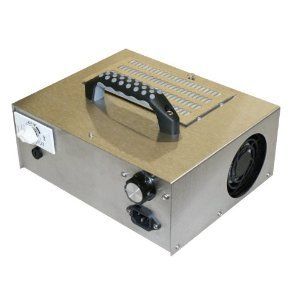An ozone generator is a device that effectively converts oxygen from different sources like dry air, ambient air, or concentrated oxygen into ozone (O3). These machines produce ozone by adding energy to the existing oxygen molecules (O2) that causes oxygen atoms to part ways and recombine temporarily with other oxygen molecules. This ozone is then used for air purification and water disinfection.
You can find ozone generators in both small hand-held sizes as well as large-scale industrial models that are capable of producing hundreds of grams of ozone every hour. The latter works in similar ways as ambient air units, except the requirement for extremely clean and dry air or oxygen along with specially designed corona spells to generate considerable ozone concentrations.
How Do Ozone Generators Work?
These ozone generating machines apply an electrical charge to the ambient air that passes through. As a result, this splits apart some of the normal oxygen atoms into their unstable single versions, which then bond with other oxygen molecules to create ozone. The ozone reacts with a pollutant, virus, bacteria, or mold, and breaks down the components into less complex and typically less harmful molecules by a process known as oxidation. The ozone that is yet to react with other molecules will gradually decompose into oxygen. The ozonation will destroy odors, disinfect air, water, and other such materials.
Although they are approved by FDA and USDA for its use on food, safety guidelines must be carefully followed at all times. You must understand the structure of the contaminants and get an ozone expert to properly size the ozone generation machine.
Types of Ozone Generation Systems
Ozone generators can be separated by aqueous v/s gaseous ozone. Let’s understand both:
Aqueous Ozone Systems
These are systems that can inject gaseous ozone into water. This ozonated water is then applied to surfaces for both disinfection or circulation in water systems. Their applications are endless- from clean-in-place (CIP) processes, food disinfection, to wastewater treatment. As compared to chlorine or UV disinfection, ozone is much more effective in eliminating bacteria and viruses while still needing little contact time. This reduces the overall treatment time while leaving no chemical residue. Owing to its high oxidation potential, ozone degrades microbes and viruses, resulting in cell membrane rupture and the gradual decomposition of essential biomolecular components. This effectively makes the water clean and free from microbes and viruses.
A necessary criterion for water treatment applications is the absence of harmful by-products from ozone use. With ozone decomposition, it reverts back into oxygen. It also inhibits regrowth of microorganisms, given other processes have already reduced particulates in the concerned wastewater.
Gaseous Ozone Systems
They can be used in a diverse range of odor mitigation and air treatment applications. The ozone here is circulated through the air to effectively treat airborne contaminants and those that could be resting on exposed surfaces. Ozone and the oxidation process can reduce, if not completely remove, airborne odors as well as contaminants.
Do follow safety guidelines and regulations of your ozone generation systems. Always conduct ozone shock treatments in unoccupied spaces, preferably by a professional ozone service partner. Continuous ozone circulation at low-treatment levels must be conducted following consultation with an ozone professional. This will ensure that the equipment is rated for continuous use, and proper safety mechanisms are in place to maintain ozone levels within the acceptable threshold.


























